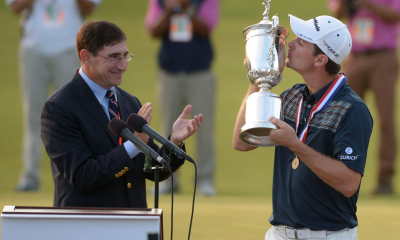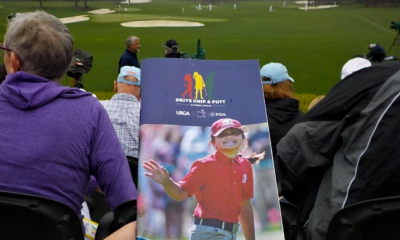Opinion & Analysis
“My handicap makes me a tremendous loser”

Congratulations to me! I am every bit as bad, and every bit as average as I thought I was! It has been a summer of having my lunch handed to me on the golf course. I wanted to believe it wasn’t all my fault. I wanted to be able to say that the way the USGA handicap system is set up, that I was destined to fail more often than not. What I found out is that failure, in my eyes and in the eyes of the USGA are two different things.
Every first and 15th day of the month, like probably millions of other golfers, I get my updated USGA handicap index emailed to me. These emails leave me shaking my head. How can I have so many rounds over par mixed in with my few great rounds a month that are under par and still end up with a handicap equating to a +3.5?
“Handicaps are there to show a golfer’s potential of shooting the course rating,” says Mary Kate Kemp, USGA Director of Handicaps and Course Rating Administrator. “It is not about your average, most people get that wrong.”
You can add me to that group of people. It seems to me that if par for a course is 72, and my stroke average for that course is 70.8, my handicap should be +1.2. I have posted 30 rounds this summer from that Tom Weiskopf gem. But I also have 30 rounds from another course that I play where the par is 71 and my stroke average is 71.9. Fair is fair, those rounds should be averaged in and my handicap must be +1.2 -0.9 for a total of +.3. I’m no math or philosophy genius but that is pure number logic right there, I don’t care who you are.
According to the USGA if a golfer posts 20 rounds in a month, the 10 highest scores are tossed and the lowest 10 are used with the slope rating of the courses to determine a player’s chances of shooting “scratch” golf. And here is yet another thing I was wrong about. Scratch golf, according to the USGA, is shooting a course’s “rating.” Par ain’t got nothing to do with it, son!
Golf courses are rated based on the length of the holes and on the number of obstacles like bunkers, ponds, trees, and everything else that is in between the tee boxes and the greens of the individual holes. The hole rated as the No. 1-handicap hole of the course may not actually be the most difficult hole on the course per se, it is more about where the people rating the course determine that the lesser skilled players would have a better chance of getting into or blocked by one of the obstacles, and or would end up having to hit an exponentially more difficult approach shot into the green based on how much more accurately a “scratch” golfer might hit a shorter club like a wedge into a green while the higher handicapper could be farther out and have as much as a five-iron in, and on that hole a stroke needs to be given to make up that difference.
Huh? Hey don’t go re-reading that previous paragraph, I’m not even sure I said it right. But how many times have we all looked at a score card and saw a hole rated a certain way and said to the guy sitting next to us in the cart with half a hot dog stuffed in his mouth, “I wonder why they have No. 1 rated as harder than No. 16?” It’s because people way smarter than us determined it should be that way.
This brings me back to me being such a tremendous loser. I look at my 20 or so rounds a month and see that I generally only shoot five or so rounds a month where I can cover the 3.5 shots I have to give back to the course to shoot the rating. So roughly 75 percent of the time my handicap is an albatross around my neck that I cannot shake. Let the self-loathing begin. There you go, breath it in.
Not so fast says Kemp and the USGA website, “You may only play to your handicap one out of five rounds or so,” she says. The USGA actually goes as far as to tell you not to be discouraged if you can only do it 20-25 percent of the time.
Where this gives me fits, and what I think is unfair, is when these handicaps are used in head-to-head matches. One such event this summer was when I was matched up against a 13 handicap in a match play affair. Before we teed off I was given our score card with 17 dots listed on the holes of the score card. It looked like a Dalmatian dog.
A quick examination of our scores posted showed that he had posted a score as low as 78 and one as high as 90 recently. My score range was a low of 64 and a high of 81. On either end of the spectrum the odds of me winning seemed quite bad.
Click here for more discussion in the “Golf Talk” forum.
I mentioned that to a fellow I know who is a strong five handicap, but prefers to carry a 10.5 for tournament purposes like these, and he bristled, “Yeah but the better player always has a better chance of not having an off day and being able to play to his handicap!”
“Really,” I said? “He shot 78 on this course last week in qualifying, if he chokes out an 85 I may still have to shoot four under to tie.” Four-under par would be one of the 25 percent of my rounds rounds the USGA bases my handicap on. For those of you keeping score at home, that means 75 percent of the time I don’t shoot that well.
Before you all berate me with deserved insults and threaten me with certain pain and misery, yes I understand that my competitor only has a 25 percent chance of shooting his handicap as well. My point was that my stroke average compared to my handicap was much more difficult to obtain than his was for him. It didn’t help that our match was over-hyped all over the club, starting with the young gun assistant pros who were taking side action.
I asked Ms. Kemp if she thought that a 13 should be able to compete with a +3.5. “Those two players are apples and oranges, really,” she said. “The skillset of a +3.5 should make it very difficult for the 13 to be competitive.
Ouch. Maybe I do stink after all. I was defeated in the match. His stroke average was about 12 shots worse than mine, but I was giving him 17 shots. There had been some talk in the earlier rounds that his handicap was notoriously “iffy,” and that when he was forced to play the tougher of the two courses at our club that those scores were always posted but not necessarily the ones from the easier course where the match was played. Either way, the difference between stroke averages would have been a more fair way to play him. I think somewhere some bright eyed mathematician needs to be able to figure out a way to weight that difference more fairly. That brings me to my next thumping.
Three years ago I played another guy in an intense head-to-head, straight-up battle that went down to the last hole. Yes, he beat me then too. But when I saw that I was going to play him this summer I was really looking forward to another great match. Then I saw the score card. He explained that he had not been posting many scores lately but that he had played in quite a few four ball tournaments and things like that. His handicap was four. So this player, who could beat me straight up on any given day, was getting seven and a half shots from me.
“You can get a handicap with as little as five posted scores,” Ms. Kemp explained, “in that instance they take your one best score and base it in the formula with the slope and the course rating.”
“There’s no question that a bigger sample of scores is more accurate though,” she added.
The course where we played has a lot of the pop holes early, and I was forced to play from behind all day and could never overcome the lead he was staked to. It was a bitter defeat. It was most bitter because I know this guy is a good player, and he’s not one to purposefully manipulate his handicap. He posted a few scores of rusty golf earlier in the spring and he posted a few as he went, but his sample was way too small to be fair.
So what about the players out there who do dishonor the whole system and keep an artificially high handicap? A great example of this was when a frequent four ball partner of mine and I played our first four ball matches as new members of a club in the annual member/member round robin tournament. We never had a chance. The joke was on us. Apparently if everyone cheats it just levels the playing field.
My partner was the same cat I mentioned before who plays to a five but now carries a 10.5. That weekend we were never close to beating anyone. There were players in the field who I had battled with for 30 years in junior golf, high school golf and college golf. These were good players. I found myself standing in the fairways with them with wedges in our hands and me giving them pops, three times in nine holes!
This brings up another aspect to the handicap system that I think is really unfair. On any given day a four handicap can beat a scratch player straight up. On any given day that four handicap player could beat a +3.5 player straight up. The chances of them both playing their best at the same time is ¼ x ¼ or 1/16. So why do they play with all of the strokes all of the time?
The difference between better players on any given day could be one more made 30-foot putt, one less wayward tee shot, one more great up and down, or anything like that. It is why over the course of four rounds Rory and Tiger generally end up beating everyone. They usually do things fractionally better than other top players, and those fractions add up.
My now former four ball partner joined the crowd and manipulated his handicap up to 10.5. I saw that he and his new partner won the member/member this summer. Hey, congratulations!
“The system is based on integrity,” Ms. Kemp adds, “but each course needs a peer review and handicap committee that can step in and police the guys that are breaking the rules.”
In a country where the number of rounds are down significantly and in an industry in decline I can’t see a club pro wanting to scare off another regular player like the guy who played in my club’s Ryder Cup matches a couple weeks ago with a less than accurate handicap. He came in with a 19 handicap and reeled off six straight pars to earn his first point for his team. Once again eyebrows were raised and feathers were ruffled, but since there was no action by a peer handicap committee, we all have ourselves to blame. By the way he reeled off those six straight pars against me and my partner in the morning four ball matches. He made par to close us out on the seventh hole of our nine-hole match. He was getting two pops on the hole.
I guess the point I am trying to make is that I don’t play well under pressure. Wait that’s not what I meant to say. What I am saying is that I wish they could make a system that was based more on averages rather than on potential. It’s interesting that they say the system is based on potential because when I tried to post a 64 this summer the machine wouldn’t let me. It spit out a message saying the score was too low! Well, maybe the machine has seen me putt.
To further prove that I don’t know what I am talking about I do have 10 or so really great head-to-head matches each summer with a buddy of mine who carries about an eight to a 10 handicap. He too posts 120 rounds or so a year. It’s uncanny how often we can play each other and have it come down to the last few holes. So maybe the system is perfect as it is.
Opinion & Analysis
The 2 primary challenges golf equipment companies face

As the editor-in-chief of this website and an observer of the GolfWRX forums and other online golf equipment discourse for over a decade, I’m pretty well attuned to the grunts and grumbles of a significant portion of the golf equipment purchasing spectrum. And before you accuse me of lording above all in some digital ivory tower, I’d like to offer that I worked at golf courses (public and private) for years prior to picking up my pen, so I’m well-versed in the non-degenerate golf equipment consumers out there. I touched (green)grass (retail)!
Complaints about the ills of and related to the OEMs usually follow some version of: Product cycles are too short for real innovation, tour equipment isn’t the same as retail (which is largely not true, by the way), too much is invested in marketing and not enough in R&D, top staffer X hasn’t even put the new driver in play, so it’s obviously not superior to the previous generation, prices are too high, and on and on.
Without digging into the merits of any of these claims, which I believe are mostly red herrings, I’d like to bring into view of our rangefinder what I believe to be the two primary difficulties golf equipment companies face.
One: As Terry Koehler, back when he was the CEO of Ben Hogan, told me at the time of the Ft Worth irons launch, if you can’t regularly hit the golf ball in a coin-sized area in the middle of the face, there’s not a ton that iron technology can do for you. Now, this is less true now with respect to irons than when he said it, and is less and less true by degrees as the clubs get larger (utilities, fairways, hybrids, drivers), but there remains a great deal of golf equipment truth in that statement. Think about it — which is to say, in TL;DR fashion, get lessons from a qualified instructor who will teach you about the fundamentals of repeatable impact and how the golf swing works, not just offer band-aid fixes. If you can’t repeatably deliver the golf club to the golf ball in something resembling the manner it was designed for, how can you expect to be getting the most out of the club — put another way, the maximum value from your investment?
Similarly, game improvement equipment can only improve your game if you game it. In other words, get fit for the clubs you ought to be playing rather than filling the bag with the ones you wish you could hit or used to be able to hit. Of course, don’t do this if you don’t care about performance and just want to hit a forged blade while playing off an 18 handicap. That’s absolutely fine. There were plenty of members in clubs back in the day playing Hogan Apex or Mizuno MP-32 irons who had no business doing so from a ballstriking standpoint, but they enjoyed their look, feel, and complementary qualities to their Gatsby hats and cashmere sweaters. Do what brings you a measure of joy in this maddening game.
Now, the second issue. This is not a plea for non-conforming equipment; rather, it is a statement of fact. USGA/R&A limits on every facet of golf equipment are detrimental to golf equipment manufacturers. Sure, you know this, but do you think about it as it applies to almost every element of equipment? A 500cc driver would be inherently more forgiving than a 460cc, as one with a COR measurement in excess of 0.83. 50-inch shafts. Box grooves. And on and on.
Would fewer regulations be objectively bad for the game? Would this erode its soul? Fortunately, that’s beside the point of this exercise, which is merely to point out the facts. The fact, in this case, is that equipment restrictions and regulations are the slaughterbench of an abundance of innovation in the golf equipment space. Is this for the best? Well, now I’ve asked the question twice and might as well give a partial response, I guess my answer to that would be, “It depends on what type of golf you’re playing and who you’re playing it with.”
For my part, I don’t mind embarrassing myself with vintage blades and persimmons chasing after the quasi-spiritual elevation of a well-struck shot, but that’s just me. Plenty of folks don’t give a damn if their grooves are conforming. Plenty of folks think the folks in Liberty Corner ought to add a prison to the museum for such offences. And those are just a few of the considerations for the amateur game — which doesn’t get inside the gallery ropes of the pro game…
Different strokes in the game of golf, in my humble opinion.
Anyway, I believe equipment company engineers are genuinely trying to build better equipment year over year. The marketing departments are trying to find ways to make this equipment appeal to the broadest segment of the golf market possible. All of this against (1) the backdrop of — at least for now — firm product cycles. And golfers who, with their ~15 average handicap (men), for the most part, are not striping the golf ball like Tiger in his prime and seem to have less and less time year over year to practice and improve. (2) Regulations that massively restrict what they’re able to do…
That’s the landscape as I see it and the real headwinds for golf equipment companies. No doubt, there’s more I haven’t considered, but I think the previous is a better — and better faith — point of departure when formulating any serious commentary on the golf equipment world than some of the more cynical and conspiratorial takes I hear.
Agree? Disagree? Think I’m worthy of an Adam Hadwin-esque security guard tackle? Let me know in the comments.
@golfoncbs The infamous Adam Hadwin tackle ? #golf #fyp #canada #pgatour #adamhadwin ? Ghibli-style nostalgic waltz – MaSssuguMusic
Podcasts
Fore Love of Golf: Introducing a new club concept

Episode #16 brings us Cliff McKinney. Cliff is the founder of Old Charlie Golf Club, a new club, and concept, to be built in the Florida panhandle. The model is quite interesting and aims to make great, private golf more affordable. We hope you enjoy the show!
Opinion & Analysis
On Scottie Scheffler wondering ‘What’s the point of winning?’

Last week, I came across a reel from BBC Sport on Instagram featuring Scottie Scheffler speaking to the media ahead of The Open at Royal Portrush. In it, he shared that he often wonders what the point is of wanting to win tournaments so badly — especially when he knows, deep down, that it doesn’t lead to a truly fulfilling life.
View this post on Instagram
“Is it great to be able to win tournaments and to accomplish the things I have in the game of golf? Yeah, it brings tears to my eyes just to think about it because I’ve literally worked my entire life to be good at this sport,” Scheffler said. “To have that kind of sense of accomplishment, I think, is a pretty cool feeling. To get to live out your dreams is very special, but at the end of the day, I’m not out here to inspire the next generation of golfers. I’m not out here to inspire someone to be the best player in the world, because what’s the point?”
Ironically — or perhaps perfectly — he went on to win the claret jug.
That question — what’s the point of winning? — cuts straight to the heart of the human journey.
As someone who’s spent over two decades in the trenches of professional golf, and in deep study of the mental, emotional, and spiritual dimensions of the game, I see Scottie’s inner conflict as a sign of soul evolution in motion.
I came to golf late. I wasn’t a junior standout or college All-American. At 27, I left a steady corporate job to see if I could be on the PGA Tour starting as a 14-handicap, average-length hitter. Over the years, my journey has been defined less by trophies and more by the relentless effort to navigate the deeply inequitable and gated system of professional golf — an effort that ultimately turned inward and helped me evolve as both a golfer and a person.
One perspective that helped me make sense of this inner dissonance around competition and our culture’s tendency to overvalue winning is the idea of soul evolution.
The University of Virginia’s Division of Perceptual Studies has done extensive research on reincarnation, and Netflix’s Surviving Death (Episode 6) explores the topic, too. Whether you take it literally or metaphorically, the idea that we’re on a long arc of growth — from beginner to sage elder — offers a profound perspective.
If you accept the premise literally, then terms like “young soul” and “old soul” start to hold meaning. However, even if we set the word “soul” aside, it’s easy to see that different levels of life experience produce different worldviews.
Newer souls — or people in earlier stages of their development — may be curious and kind but still lack discernment or depth. There is a naivety, and they don’t yet question as deeply, tending to see things in black and white, partly because certainty feels safer than confronting the unknown.
As we gain more experience, we begin to experiment. We test limits. We chase extreme external goals — sometimes at the expense of health, relationships, or inner peace — still operating from hunger, ambition, and the fragility of the ego.
It’s a necessary stage, but often a turbulent and unfulfilling one.
David Duval fell off the map after reaching World No. 1. Bubba Watson had his own “Is this it?” moment with his caddie, Ted Scott, after winning the Masters.
In Aaron Rodgers: Enigma, reflecting on his 2011 Super Bowl win, Rodgers said:
“Now I’ve accomplished the only thing that I really, really wanted to do in my life. Now what? I was like, ‘Did I aim at the wrong thing? Did I spend too much time thinking about stuff that ultimately doesn’t give you true happiness?’”
Jim Carrey once said, “I think everybody should get rich and famous and do everything they ever dreamed of so they can see that it’s not the answer.”
Eventually, though, something shifts.
We begin to see in shades of gray. Winning, dominating, accumulating—these pursuits lose their shine. The rewards feel more fleeting. Living in a constant state of fight-or-flight makes us feel alive, yes, but not happy and joyful.
Compassion begins to replace ambition. Love, presence, and gratitude become more fulfilling than status, profits, or trophies. We crave balance over burnout. Collaboration over competition. Meaning over metrics.
Interestingly, if we zoom out, we can apply this same model to nations and cultures. Countries, like people, have a collective “soul stage” made up of the individuals within them.
Take the United States, for example. I’d place it as a mid-level soul: highly competitive and deeply driven, but still learning emotional maturity. Still uncomfortable with nuance. Still believing that more is always better. Despite its global wins, the U.S. currently ranks just 23rd in happiness (as of 2025). You might liken it to a gifted teenager—bold, eager, and ambitious, but angsty and still figuring out how to live well and in balance. As much as a parent wants to protect their child, sometimes the child has to make their own mistakes to truly grow.
So when Scottie Scheffler wonders what the point of winning is, I don’t see someone losing strength.
I see someone evolving.
He’s beginning to look beyond the leaderboard. Beyond metrics of success that carry a lower vibration. And yet, in a poetic twist, Scheffler did go on to win The Open. But that only reinforces the point: even at the pinnacle, the question remains. And if more of us in the golf and sports world — and in U.S. culture at large — started asking similar questions, we might discover that the more meaningful trophy isn’t about accumulating or beating others at all costs.
It’s about awakening and evolving to something more than winning could ever promise.





















Brunty
Jan 8, 2013 at 3:03 am
I don’t know whether your handicap system has changed now or not but in Australia we have an anchor in place. The anchor lasts for 12mths and your handicap can’t go more than 4 shots hirer. For example my lowest is 6.3, so my highest handicap can only be 10.3. The anchor resets if you get to a lower handicap or if the 12mths is up it moves to your next lowest handicap. This has stopped a few cheaters
DCGolf
Oct 4, 2012 at 10:46 pm
Play more scratch events; there are plenty of them out there and as a +4 you’re gonna win a bunch of them. Because then the ball is in ur court, there are a lot of guys playing them who are not even close to scratch.
Tim Gavrich
Oct 3, 2012 at 10:59 am
This makes a lot of sense. The better you get as a player, the closer you get in score to your potential. Just ask yourself: In general, who is more likely to shoot five shots better than his handicap, the 12 or the +3? On a par 72 golf course, the average 12 is going to break 80 more often than the average +3 is going to shoot 64.
Kevin, to play those higher-handicappers, do you move forward a set of tees or do they move back? Even though the Course Rating system should make it irrelevant, in practice it matters. I’d feel like the match was fairer if I were giving 15 shots to the 12 if her were playing all the way back with me than I would moving up to give him the 15. This is usually because a lot of golf courses, if a good player plays from shorter tees, he’s probably going to hit shorter clubs off the tee and hit his approaches from not an incredibly different spot on most holes.
Jim
Oct 3, 2012 at 9:28 am
Be happy to be a scratch, being a single digit and now going north to a 10 doesn’t feel great- the point is: its not a bad problem to have.
As a 10, I’d have to shoot a career round as someone mentioned earlier- if you feel like your buddies keep having career rounds against you- they may be sandbagging …
Boomboom
Oct 2, 2012 at 3:44 pm
Bottom line. Your handicap is your handicap. If you are honest, there is no such thing as a good or bad 5, etc. I post every score and carry a 6.5. I hate playing scratch golfers that bitch and wine during a money game about how many strokes they are giving, but they’ll brag all day in the pro shop that they are scratch.
Carter
Oct 2, 2012 at 8:13 am
Agree with Kemp, peer review a must at clubs. Recommend you consult Appendix E of Handicap Manual to determine the probability of shooting exceptional score also check out Pope of Slope web site for additional info. That said, I feel your pain, I frequently lose to players shooting “career” rounds. I particularly dislike playing off the low handicap ball. I guess like they say, if we want to win, play better.
titleistbb
Oct 1, 2012 at 8:03 pm
As a +2.2 I agree with your post. I was so tired of being pencil-whipped I only play scratch events now. Much more fun. I would suggest that. I played in my clubs premier member guest this summer with a $1,000 entry fee and got to watch an 8 shoot a natural 33 on me for 9 holes. I think this is statisticaly impossible. Daddy was on the handicap committee so not a word could be said. Funny thing was that while having lunch I saw his name on the wall as being a former club champ. Fantastic.
eagle_garrey
Oct 1, 2012 at 3:17 pm
humblebrag